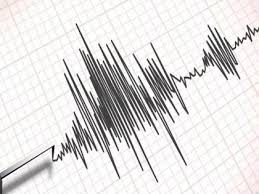Tajikistan Earthquake: Two Quakes Strike The Country, No Major Damage Reported
By Lokmat English Desk | Updated: April 13, 2025 12:43 IST2025-04-13T12:41:49+5:302025-04-13T12:43:09+5:30
Over the past few days, several epicenters have been recorded along the Afghanistan-Tajikistan border, indicating heightened seismic activity in the area.

Tajikistan Earthquake: Two Quakes Strike The Country, No Major Damage Reported
A series of earthquakes rattled Tajikistan and neighboring regions over the weekend, sparking panic among residents and raising concerns about ongoing seismic activity in the region. On Sunday, Tajikistan was rocked by two powerful earthquakes within the span of an hour. The first tremor, measured at a magnitude of 6.1 on the Richter scale, struck the mountainous regions of the country and was described as "extremely dangerous." The sudden quake sent residents fleeing their homes in fear. Despite the intensity, no major casualties or significant damage have been reported so far.
These tremors follow a similar quake on Saturday afternoon around 12:30 PM, when a 4.2 magnitude earthquake hit Tajikistan. Over the past few days, several epicenters have been recorded along the Afghanistan-Tajikistan border, indicating heightened seismic activity in the area. Sunday’s events mark the second instance of earthquakes occurring in Tajikistan within 24 hours.
The impact of seismic activity was felt beyond Tajikistan as well. On Saturday, tremors were reported in India, particularly in Kashmir, as well as in Pakistan, Tonga, and Papua New Guinea. These quakes varied in strength, ranging from magnitudes of 4.0 to 6.0. Tajikistan and Pakistan experienced stronger jolts, while Tonga and Papua New Guinea recorded earthquakes reaching a magnitude of 6.0.
In Pakistan, a 5.8 magnitude earthquake struck on Saturday afternoon, with its epicenter located near Rawalpindi, close to the capital Islamabad. Tremors were reported in several areas, including Islamabad, Attock, Chakwal, and parts of the Punjab province.
Also Read: US: One person dead after small plane crashes near New York's Copake
Experts attribute the frequent earthquakes to tectonic activity beneath the Earth's surface. The planet is divided into seven major tectonic plates that are constantly in motion. When these plates collide, stress builds up along their edges, eventually releasing energy in the form of earthquakes. This natural process continues to shape the dynamic geology of the region.
Authorities are monitoring the situation closely, and residents have been urged to remain vigilant as aftershocks may continue.Open in app